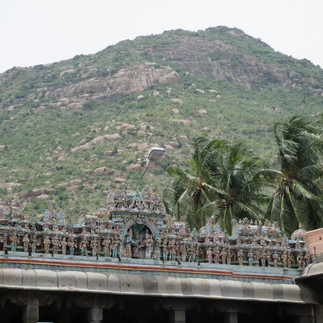அண்ணாமலையார் திருக்கோயில், திருவண்ணாமலை
One of the five Panchabootha Sthalams, this is one of the most important Sivasthalams. Located in the town of Thiruvannamalai, the Annamalaiyar or Arunachaleswarar is an ancient and very significant temple. It is the Panchaboothasthalam associated with fire or Agni.
Lord Siva manifests here as the Agni Lingam in the sanctum sanctorum. It is a Paadal Petra Sthalam sung in praise by all three of the Moovar, Thirugnanasampanthar, Thirunavukkarasar and Sundaramoorthy Nayanar. Manickavasagar composed the Thiruvempaavai here.
Throughout history Thiruvannamalai has been a magnet for the spiritually and philosophically inclined, more so than other temples in South India. The modern day saint, Ramanamaharishi spent most of his life here drawing hundreds of followers to his Ashram. The temple lies at the foot of the holy hill of Thiruvannamalai. The mountain itself is considered sacred and is venerated. Every year in the Tamil month of Karthigai (November/December), thousands flock to this temple to witness the Karthigai Deepam when a giant fire is lit on the top of the holy hill of Arunachala. It is visible for miles around and is a grand spectacle. Legend says that once Shiva manifested as a huge column of fire here and asked Lord Vishnu and and Lord Brahma to find the bottom and top of this fiery column. The column of fire solidified into the holy mountain of Thiruvannamalai or Arunagiri. Every year in November and every fortnight on the Pradosham and on other special days, thousands of believers undertake the trek around the mountain called the Girivalam.
The temple has ancient origins. As a Paadal Petra Sthalam, it certainly existed in some form in the early 7th century. At that time it was under the Pallavas. The earliest structures according to inscriptions are from the 9th century under the Cholas. During the nearly four centuries of Chola rule from the 9th to the 13th centuries, they rebuilt and expanded this temple. It was later maintained by the resurgent Pandians in the 13th century and subsequently came under the control of the Hoysala kings. In 1328 the great Hoysala king Veera Ballala III, under increasing pressure from the Sultanates to the north, shifted his capital to Thiruvannamalai from present day Karnataka. He expanded the temple. A lot of the structures and traditions, present today are from his time. He was defeated by Ghiyas-ud-din Muhammad Damghani, the Sultan of Madurai, at the battle of Kannanur near Thiruchirapalli in 1343 where he was captured, killed and flayed (skinned). This led to a decline in the maintenance of the temple only to be revived by the Vijayanagar emperors in the late 14th to 16th centuries. All three dynasties of Vijayanagar, the Sangama, the Saluva and the Tuluva have left inscriptions here. This was continued by the Nayakkar. The temple was briefly in the hands of the Nawab of Arcot before slipping into the possession of French and then British administrations.
Spreading over 25 acres, it is one of the largest temple complexes in India . It has tall gopurams on all sides. White in colour, they look majestic. The tallest is the Eastern Gopuram at 217 feet. It is one of the tallest temple towers in all of India. It was built by the great Vijayanagar emperor Krishnadevaraya. It also has a large thousand pillared hall built during the Vijayanagar period. There are seven prakarams or circumambulatory pathways.
Today it is controlled by the HR and CE Department of the Government of Tamil Nadu. Given the great cultural importance of the temple, the ASI or the Archeological Survey of India declared it a monument of national importance and took over its stewardship in 2002. The Tamil Nadu Government sued against the decision and it was returned to the control of the HR and CE by the Supreme Court of India.
It is about 2 hours or 90 km south of Vellore and 2 hours or 100 km west of Pondicherry.
We visited in August 2014. We were based in Salem.

Credits: Google Maps


















Here is an informative and well done video about the temple. Credits to the creators the YouTube Channel Tarkshya Picures by Sonu Surag
https://youtu.be/jFUwEoiwfMY?si=pC2c4H4ZSyoJfryF